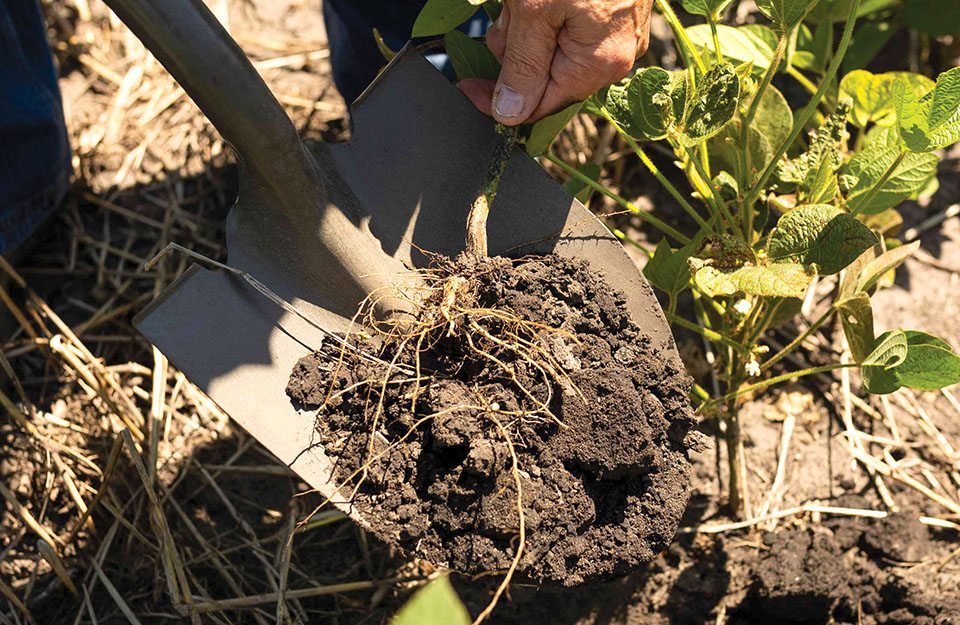
(Photo: Iowa Soybean Association / Joclyn Bushman)
The fight against soybean cyst nematode
February 5, 2024 | Kriss Nelson
As the cause of $1.5 billion yearly in yield loss, the soybean cyst nematode (SCN) is undoubtedly the most damaging pest affecting soybeans in the United States.
“Soybean cyst nematode is like the Energizer bunny — it just keeps going and going,” says Greg Tylka, Morrill professor and co-director of the Iowa Soybean Research Center at Iowa State University.
Rotating soybeans with corn, growing resistant soybean varieties and using seed treatments are the primary tools farmers can use to be defensive against SCN.
SCN Profit Checker
Many, if not most, SCN populations in Iowa have increased reproduction levels on soybean varieties with SCN resistance from the breeding line named PI 88788. The loss of resistance happened because of widespread and continued use of only PI 88788 SCN resistance since the early 1990s. And greater reproduction of SCN on varieties with PI 88788 SCN resistance means increased yield loss.
Unfortunately, most farmers have no choice but to grow soybean varieties with PI 88788 SCN resistance because those soybeans represent 90% of the varieties available to grow in Iowa, according to Tylka.
How much is SCN costing you because of the reduced effectiveness of PI 88788 resistance?
The SCN Coalition has created a new tool for farmers and crop advisors to help answer that question.
The SCN Profit Checker became available to soybean farmers in September and in its first three months, was used more than 20,000 times.
The SCN Profit Checker is a calculator powered by data collected from more than 35,000 Iowa State University research plots throughout Iowa over 20 years. Much of the research was funded by Iowa soybean checkoff dollars. The SCN Profit Checker uses starting egg count, soil pH, sand content of the soil and a SCN female index to estimate yield loss. These four factors consistently affected yield loss in the data set on which the calculator was built.
There are three simple steps to using the SCN Profit Checker:
1) Access the tool at thescncoalition.com/profitchecker
2) Enter your field’s info, including SCN egg count (per 100 ccs of soil), SCN female index on PI 88788, sand percentage and soil pH.
The SCN egg count is obtained by collecting and testing a soil sample for SCN. The Iowa State University Plant and Insect Diagnostic Clinic processes SCN soil samples. Many private soil-testing labs also process samples for SCN.
The female index of an SCN population on PI 88788 indicates how well the nematode population in the field can reproduce on soybeans with PI 88788 SCN resistance. The female index comes from an HG (Heterodera glycines)-type test conducted on the SCN population in a soil sample collected from the field. If a farmer does not have this information, there is a default female index value on PI 88788 entered into the calculator for Iowa that can be used to estimate yield loss.
The pH and sand content of the soil can be determined from a soil sample submitted to most soil-testing laboratories.
3) Make a plan.
After the calculator estimates your yield loss from SCN, Tylka encourages farmers to work with a trusted crop advisor or agronomist to determine a plan to actively manage SCN.
“Knowing what’s happening in each field gives you more information to make educated decisions on how to manage that field in terms of soybean production,” says Tylka. “The Profit Checker puts potential yield loss from SCN in real dollars and cents.”
SCN resistance concerns
Growing soybeans with Peking resistance is the other option available to control SCN.
But research, including work funded by the North Central Soybean Research Program, indicates that Peking resistance will not maintain its durability when used four or five years consecutively.
“The sustainable approach is to use both types of resistance genetics,” says Tylka. “It took 30 years for PI 88788 to wear out, but it won’t take Peking that long because it has a different mode of action. If we are lucky, we think it will maintain effectiveness for 10 years. But we may be able to prolong its effectiveness for a few decades by alternating between the two types of resistance genetics.”
Early 2023 yield data shows increasing yield differences between Peking and PI 88788, with Peking coming out on top.
Soybean varieties with Peking SCN resistance are often the top-yielding in SCN-infested fields in which varieties with PI 88788 SCN resistance was grown repeatedly. With a 10- to 20-bushel-peracre yield bump over varieties with PI 88788 SCN resistance, farmers may want to use Peking resistance every time they grow soybeans in SCN-infested fields.
“Unfortunately, it is a must that farmers rotate between Peking and PI 88788, or we will end up back to the days where we were struggling to achieve 50 bushels to the acre soybeans in SCN-infested fields,” says Tylka. “We will slip back in a matter of a decade or so if we overuse Peking resistance.”
Tylka advises producers to consider using seed treatments — either chemical or biological — to protect yields in SCN-infested fields.
“I encourage farmers to experiment with them on their fields because our research shows variable results among products and locations.”
The battle against Soybean Cyst Nematode could be a “SNAP”
Greg Tylka, Morrill professor and co-director of the Iowa Soybean Research Center at Iowa State University, says managing the soybean cyst nematode could be a “SNAP,” encouraging farmers to follow this acronym while making SCN management decisions for 2024 and beyond.
S: START using varieties with Peking resistance in SCN-infested fields. Seed companies have more than doubled the number of Peking-resistant varieties from 40 a year ago to 87.
N: NEVER grow Peking-resistant varieties twice in a row. Peking-resistant varieties will lose their effectiveness if overused.
A: ALWAYS grow varieties with PI 88788 resistance after growing Peking resistance.
P: PLANT corn every year after growing a SCN-resistant variety.
Back